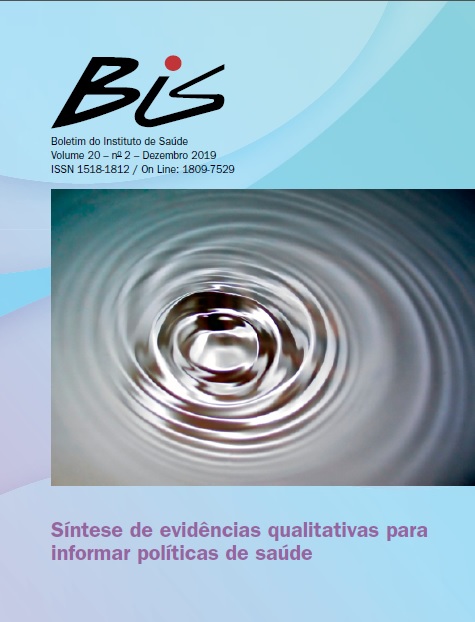Abstract
The objective was to evaluate the application and implementation of clinical management by kanban in the emergency hospital ser-vices (EHS). Method: Qualitative systematic review with metassyn-thesis. Data collection was carried out in the following information sources: Web of Science, Scopus, CINAHL, PsycoInfo, Embase, Eric, Pubmed (included Medline), Lilacs, ScienceDirect, Google Scholar. Following descriptors were used: health personnel; com-prehensive health care; patient care team; continuity of patient care; quality improvement; patient centered care; healthcare; gui-de to clinical practice; lean thinking; quality of health care; lean management; hospital emergency service; hospital/hospital logis-tics; emergency medical services. Articles in English, Portuguese and Spanish published between 2008 and 2016 were selected. It was used methodological quality analysis tools of qualitative re-search and data extraction from JBI-SUMARI. The categorization of the findings was performed on the basis of meaning similarity and the categories were aggregated into synthesis. Results: The-re were included 22 articles, aggregated in eight categories and three synthesis. Kanban appears as a lean-related tool in EHS. The implementation of the lean should be further explored in the emergency services, focusing on sustainability, time of care and user satisfaction.
References
2. Ramanantso AB. Strategic Technology Management. Chi-chester, UK: John Wiley & Sons; 1992.
3. Farrohknia N, Castrén M, Ehrenberg A, Lind L, Oredsson S, Johsson H, Asplund K, Goransson K. Emergency Depart-ment Triage Scales and Their Components: a Systematic Review of their Scientific Evidence. Scand J Trauma Resusc Emerg Med. 2011; 19:42.
4. Azeredo TR, Guedes HM, Rebelo de Almeida RA, Chianca TC, Martins. Efficacy of the Manchester Triage System: a systematic review. Int Emerg Nurs. 2015; 23(2):47- 52.
5. Mazzocato P, Savage C, Brommels M, Aronsson H, Thor J. Lean thinking in healthcare: a realist review of the literature. Qual Saf Health Care. 2010; 19:376-382.
6. Andersen A, Rovik KA, Ingebrigtsen T. Lean thinking in hospitals: is thre a cure for the absence of evidence? A syte-matic review of reviews. BMJ Open. 2014; 4.
7. Egger M, Davey Smith G, Altman DG. Systematic Reviews in Health Care: Meta- analysis in context. 2001.
8. Lopes ALM, Fracolli LA. Revisão sistemática de litera-tura e metassíntese qualitativa: considerações sobre sua aplicação na pesquisa em enfermagem. Texto Contexto En-ferm, Florianópolis. 2008; 17(4): 771-8.
9. JBI - Joanna Briggs Institute. Joanna Briggs Institute Reviewer’s Manual 2011. Institute Joanna Briggs; 2011.
10. Moher D, Liberati A, Tetzlaff J, Altman DG. Preferred Re-porting Items for Systematic Reviews and Meta-Analyses: The PRISMA Statement. PLoS Med. 2009; 6(6).
11. Munn Z, Porrit K, Lockwood C, Aromataris E, Pearson A. Establishing confidence in the output of qualitative research synthesis: the ConQual approach BMC Medical Research Methodology. 2014; 14:108.
12. G Leggat S, Gough R, Bartram T, Stanton P, Bamber GJ, Ballardie R, Sohal A. Process redesign for time-based emergency admission targets. J Health Organ Manag. 2016; 19;30(6):939-49.
13. Beck MJ, Okerblom D, Kumar A, Bandyopadhyay S, Scal-zi LV. Lean intervention improves patient discharge times, improves emergency department throughput and reduces congestion. Hosp Pract. 2016; 44(5):252-259.
14. Mazzocato P, Thor J, Bäckman U, Brommels M, Carlsson J, Jonsson F, Hagmar M, Savage C. Complexity complicates lean: lessons from seven emergency services. J Health Or-gan Manag. 2014; 28(2):266-88.
15. Timmons S, Coffey F, Vezyridis P. Implementing lean me-thods in the emergency department: the role of professions and professional status. J Health Organ Manag. 2014; 28(2):214-28.
16. Dickson EW, Anguelov Z, Vetterick D, Eller A, Singh S. Use of lean in the emergency department: a case series of 4 hospitals. Ann Emerg Med. 2009; 54(4):504-10.
17. Parks JK, Klein J, Frankel HL, Friese RS, Shafi S. Dissec-ting delays in trauma care using corporate lean six sigma methodology. J Trauma. 2008; 65(5):1098-104.
18. Dickson EW, Singh S, Cheung DS, Wyatt CC, Nugent AS. Application of lean manufacturing techniques in the Emer-gency Department. JEmergMed. 2009; 37(2):111-82.
19. Santos, VM. O que é Lean Healthcare e como is-so está mudando a saúde? [internet]. 2017 [acesso em 5 jul 2017]. Disponível em: https://www.fm2s.com. br/o-que-e-lean-healthcare/.
20. InfoQ. Kanban com o pioneiro: Entrevista com Da-vid J. Anderson. 2012 [acesso em: 10 jul 2017]. Dis-ponível em: https://www.infoq.com/br/articles/kanban-david-anderson-conceitos-e-mitos.
21. Ministério da Saúde (BR). Portaria 1.660/2011. Refor-mula a Política Nacional de Atenção às Urgências e institui a Rede de Atenção às Urgências no Sistema Único de Saú-de - SUS, 2012.
22. Ministério da Saúde (BR). Portaria nº 1663 de 6 de agosto de 2012. Dispõe sobre o Programa SOS Emergên-cias no âmbito da Rede de Atenção às Urgências e Emer-gências, 2012.
23. Petry D. Análise de implantação do Kanban em Hos-pitais do Programa SOS Emergências [dissertação]. Bahia: Faculdade de Medicina da UFBA; 2016.
24. Womack JP, Byrne AP, Fiume OJ, Kaplan GS, Toussaint J, Miller D. Going Lean in Health Care. Int Health Care Improv. Cambridge; 2005.
25. Joosten T, Bongers I, Janssen R. Application of lean thinking to health care: issues and observations. Int J Qual Health Care. 2009; 21:341-347.

This work is licensed under a Creative Commons Attribution 4.0 International License.
Copyright (c) 2019 Mariana Cabral Schveitzer, Allan Gomes de Lorena, Beatriz de Almeida Simmerman de Almeida Simmerman, Ademar Arthur Chioro dos Reis, Luiz Carlos de Oliveira Cecilio, Rosemarie Andreazza
